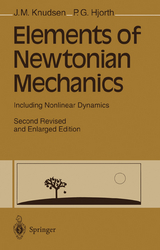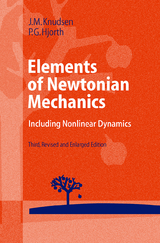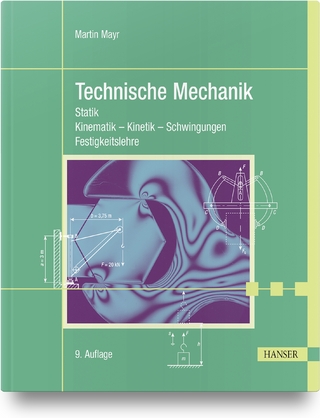Elements of Newtonian Mechanics
Springer Berlin (Verlag)
978-3-540-60841-7 (ISBN)
- Titel erscheint in neuer Auflage
- Artikel merken
1. The Foundation of Classical Mechanics.- 1.1 Principia.- 1.2 Prerequisites for Newton.- 1.3 The Masterpiece.- 1.4 Concluding Remarks.- 1.5 Problems.- 2. Newton's Five Laws.- 2.1 Newton's Laws of Motion.- 2.2 Integration of the Equation of Motion.- 2.3 Problems.- 3. Gravitational and Inertial Mass.- 3.1 Gravitational Mass.- 3.2 Inertial Mass.- 3.3 Proportionality Between Inertial and Gravitational Mass.- 3.4 Newton's Experiment.- 3.5 Problem.- 4. The Galilei Transformation.- 4.1 The Galilei Transformation.- 4.2 Galileo Speaks.- 4.3 Problems.- 5. The Motion of the Earth.- 5.1 Examples.- 5.2 Problems.- 6. Motion in Accelerated Reference Frames.- 6.1 Newton's 2nd Law Within Accelerated Reference Frames.- 6.2 The Equivalence Principle of Mechanics.- 6.3 The Einstein Box.- 6.4 The Centrifugal Force.- 6.5 Tidal Fields.- 6.6 The Coriolis Force.- 6.7 Tidal Forces and Local Inertial Frames.- 6.8 The Foucault Pendulum.- 6.9 Newton's Bucket.- 6.10 Review: Fictitious Forces.- 6.11 Problems.- 7. The Problem of Motion.- 7.1 Kinematic and Dynamic Views of the Problem of Motion.- 7.2 Einstein Speaks.- 7.3 Symmetry.- 7.4 The Symmetry (Invariance) of Newton's 2nd Law.- 7.5 Limited Absolute Space.- 7.6 The Asymmetry (Variance) of Newton's 2nd Law.- 7.7 Critique of the Newtonian View.- 7.8 Concluding Remarks.- 8. Energy.- 8.1 Work and Kinetic Energy.- 8.2 Conservative Force Fields.- 8.3 Central Force Fields.- 8.4 Potential Energy and Conservation of Energy.- 8.5 Calculation of Potential Energy.- 8.6 The Gravitational Field Around a Homogeneous Sphere.- 8.7 Examples.- 8.8 Review: Conservative Forces and Potential Energy.- 8.9 Problems.- 9. The Center-of-Mass Theorem.- 9.1 The Center of Mass.- 9.2 The Center-of-Mass Frame.- 9.3 Examples.- 9.4 Review: Center of Mass andCenter-of-Mass Theorems.- 9.5 Comments on the Conservation Theorems.- 9.6 Problems.- 10. The Angular Momentum Theorem.- 10.1 The Angular Momentum Theorem for a Particle.- 10.2 Conservation of Angular Momentum.- 10.3 Torque and Angular Momentum Around an Axis.- 10.4 The Angular Momentum Theorem for a System of Particles.- 10.5 Center of Gravity.- 10.6 Angular Momentum Around the Center of Mass.- 10.7 Review: Equations of Motion for a System of Particles.- 10.8 Examples of Conservation of Angular Momentum.- 11. Rotation of a Rigid Body.- 11.1 Equations of Motion.- 11.2 The Rotation Vector.- 11.3 Kinetic Energy.- 11.4 An Arbitrary Rigid Body in Rotation Around a Fixed Axis.- 11.5 Calculation of the Moment of Inertia for Simple Bodies.- 11.6 Equation of Motion for a Rigid Body Rotating Around a Fixed Axis.- 11.7 Work and Power in the Rotation of a Rigid Body Around a Fixed Axis.- 11.8 The Angular Momentum Theorem Referred to Various Points.- 11.9 Examples.- 11.10 Review: Linear Motion and Rotation About a Fixed Axis.- 11.11 Problems.- 12. The Laws of Motion.- 12.1 Review: Classical Mechanics.- 12.2 Remarks on the Three Conservation Theorems.- 12.3 Examples.- 12.4 Problems.- 13. The General Motion of a Rigid Body.- 13.1 Inertia in Rotational Motion.- 13.2 The Inertia Tensor.- 13.3 Euler's Equations.- 13.4 Kinetic Energy.- 13.5 Determination of the Principal Coordinate System.- 13.6 Problems.- 14. The Motion of the Planets.- 14.1 Tycho Brahe.- 14.2 Kepler and the Orbit of Mars.- 14.3 Conic Sections.- 14.4 Newton's Law of Gravity Derived from Kepler's Laws.- 14.5 The Kepler Problem.- 14.6 The Effective Potential.- 14.7 The Two-Body Problem.- 14.8 Double Stars: The Motion of the Heliocentric Reference Frame.- 14.9 Review: Kepler Motion.- 14.10 Examples.- 14.11 Problems.-15. Harmonic Oscillators.- 15.1 Small Oscillations.- 15.2 Energy in Harmonic Oscillators.- 15.3 Free Damped Oscillations.- 15.4 Energy in Free, Weakly Damped Oscillations.- 15.5 Forced Oscillations.- 15.6 The Forced Damped Harmonic Oscillator.- 15.7 Frequency Characteristics.- 15.8 Power Absorption.- 15.9 The Q-Value of a Weakly Damped Harmonic Oscillator.- 15.10 The Lorentz Curve.- 15.11 Complex Numbers.- 15.12 Problems.- 16. Remarks on Nonlinearity and Chaos.- 16.1 Determinism vs Predictability.- 16.2 Linear and Nonlinear Differential Equations.- 16.3 Phase Space.- 16.4 A Forced, Damped Nonlinear Oscillator.- 16.5 Liapunov Exponents.- 16.6 Chaos in the Solar System.- 16.7 Problems.- Appendix. Vectors and Vector Calculus.- Selected References.- Answers to Problems.
| Erscheint lt. Verlag | 3.9.1996 |
|---|---|
| Zusatzinfo | XVII, 437 p. |
| Verlagsort | Berlin |
| Sprache | englisch |
| Maße | 155 x 235 mm |
| Gewicht | 676 g |
| Themenwelt | Naturwissenschaften ► Physik / Astronomie ► Mechanik |
| Naturwissenschaften ► Physik / Astronomie ► Quantenphysik | |
| Naturwissenschaften ► Physik / Astronomie ► Theoretische Physik | |
| Schlagworte | classical mechanics • Klassische Mechanik • Newtonian Mechanics • Newtonsche Mechanik • rigid body |
| ISBN-10 | 3-540-60841-9 / 3540608419 |
| ISBN-13 | 978-3-540-60841-7 / 9783540608417 |
| Zustand | Neuware |
| Haben Sie eine Frage zum Produkt? |
aus dem Bereich





